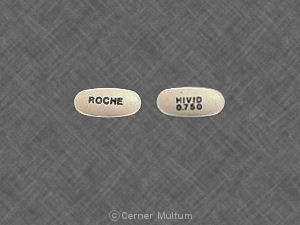Zalcitabine Dosage
Applies to the following strengths: 0.375 mg; 0.75 mg
Usual Adult Dose for:
Additional dosage information:
Usual Adult Dose for HIV Infection
0.75 mg orally every 8 hours.
Renal Dose Adjustments
CrCl < 10 mL/min: 0.75 mg orally every 24 hours.
CrCl 10-40 mL/min: 0.75 mg orally every 12 hours.
Liver Dose Adjustments
No adjustment recommended. However, treatment should be suspended if clinical or laboratory signs of lactic acidosis or hepatotoxicity develop.
Rare cases of hepatic failure and death have occurred and may be related to the use of zalcitabine in patients with underlying Hepatitis B infection. The drug should be used with caution in patients with hepatomegaly, hepatitis, or other known risk factors for liver disease.
Dose Adjustments
For toxicities that are likely to be associated with zalcitabine (e.g., peripheral neuropathy, severe oral ulcers, pancreatitis, elevated liver function tests especially in patients with chronic Hepatitis B) zalcitabine should be interrupted or dose reduced. For severe toxicities or those persisting after dose reduction, zalcitabine should be interrupted.
Patients developing moderate discomfort with signs or symptoms of peripheral neuropathy should stop zalcitabine. Zalcitabine-associated peripheral neuropathy may continue to worsen despite interruption. Zalcitabine should be reintroduced at 50% dose--0.375 mg every 8 hours only if all findings related to peripheral neuropathy have improved to mild symptoms. Zalcitabine should be permanently discontinued if patients experience severe discomfort related to peripheral neuropathy or moderate discomfort that progresses. If other moderate to severe clinical adverse reactions or laboratory abnormalities (such as increased liver function tests) occur, then zalcitabine and/or the other potential causative agent(s) should be interrupted until the adverse reaction abates. Zalcitabine and/or the other potential causative agent(s) should then be carefully reintroduced at lower doses if appropriate. If adverse reactions recur at the reduced dose, therapy should be discontinued.
Precautions
In patients with poor bone marrow reserve, particularly those patients with advanced symptomatic HIV disease, frequent monitoring of hematologic indices is recommended to detect serious anemia or granulocytopenia. Significant toxicities, such as anemia (hemoglobin of <7.5 g/dL or reduction of >25% of baseline) and/or granulocytopenia (granulocyte count of <750 cells/mm(cube) or reduction of >50% from baseline), may require a treatment interruption of zalcitabine and zidovudine until evidence of marrow recovery is observed. For less severe anemia or granulocytopenia, a reduction in daily dose of zidovudine in those patients receiving combination therapy may be adequate. In patients who experience hematologic toxicity, reduction in hemoglobin may occur as early as 2-4 weeks after initiation of therapy, and granulocytopenia usually occurs after 6-8 weeks of therapy. In patients who develop significant anemia, dose modification does not necessarily eliminate the need for transfusion. If marrow recovery occurs following dose modification, gradual increases in dose may be appropriate depending on hematologic indices and patient tolerance.
The use of zalcitabine has been associated with significant clinical adverse events, some of which are potentially fatal. Patients with decreased CD4 cell counts may be at a greater risk for experiencing these adverse events.
Zalcitabine can cause severe peripheral neuropathy. Peripheral neuropathy is characterized by numbness, burning, tingling, and later, pain, of the distal extremities. The drug should be used with extreme caution in patients with preexisting neuropathy or if being treated with other neurotoxic drugs.
Zalcitabine may also cause, although rarely, pancreatitis. The drug should be used cautiously in patients with a history of pancreatitis and should be discontinued immediately if a patient develops signs and symptoms of pancreatitis. It should not be restarted until the diagnosis of pancreatitis is excluded.
Zalcitabine has been associated with rare incidences of lactic acidosis and severe hepatomegaly with steatosis, both of which may be potentially fatal. Lactic acidosis should be suspected if there is unexplained tachypnea, dyspnea, or fall in serum bicarbonate level, and therapy should be suspended until acidosis can be ruled out.
Zalcitabine should always be used in combination with other antiretroviral agents. It should not be added as a single agent when antiretroviral regimens are changed due to the development of drug resistance and loss of virological response. The US Department of Health and Human Services HIV guidelines do not recommend combination use of zalcitabine with zidovudine, stavudine, didanosine, or lamivudine.
Safety and effectiveness have not been established in patients <13 years old.
Dialysis
Data not available
Other Comments
Periodic complete blood counts and clinical chemistry tests should be performed. Serum amylase levels should be monitored in those individuals who have a history of elevated amylase, pancreatitis, ethanol abuse, who are on parenteral nutrition or who are otherwise at high risk of pancreatitis. Careful monitoring for signs or symptoms suggestive of peripheral neuropathy is recommended, particularly in individuals with a low CD4 cell count or who are at a greater risk of developing peripheral neuropathy while on therapy.
More about zalcitabine
- Check interactions
- Compare alternatives
- Side effects
- During pregnancy
- Drug class: nucleoside reverse transcriptase inhibitors (NRTIs)
Related treatment guides
Further information
Always consult your healthcare provider to ensure the information displayed on this page applies to your personal circumstances.


